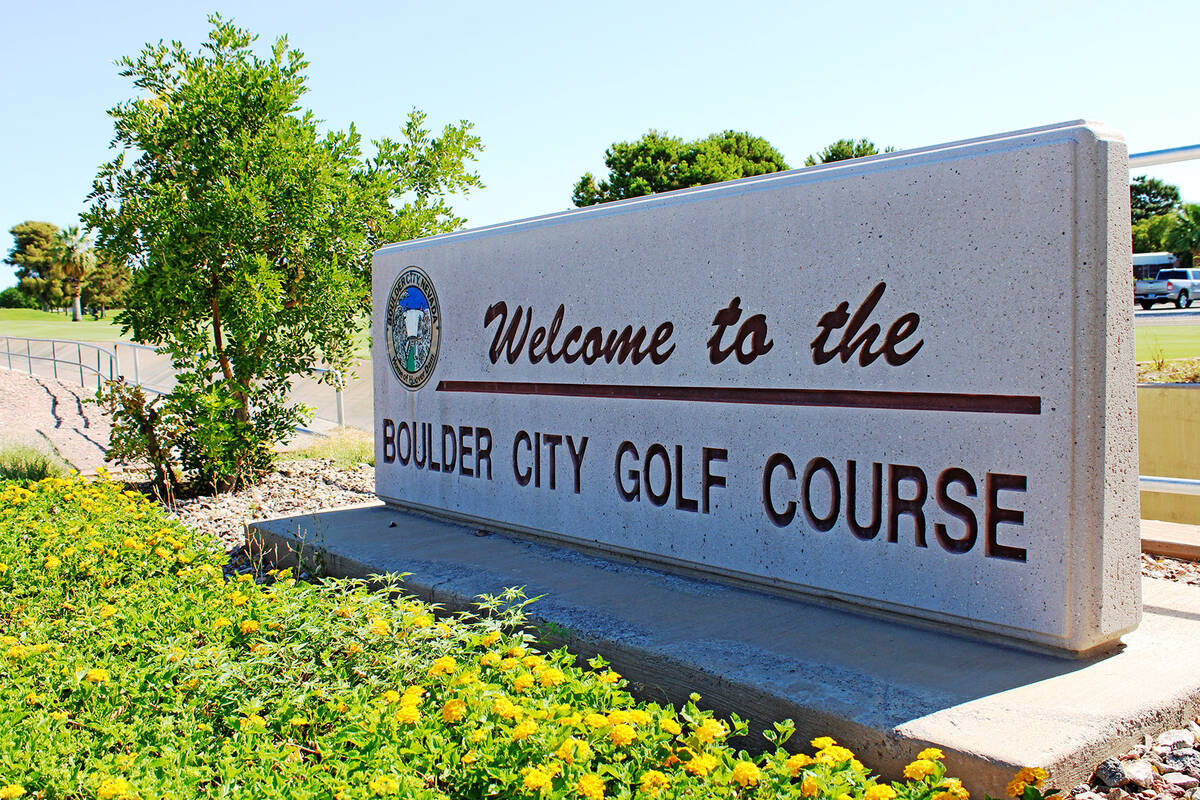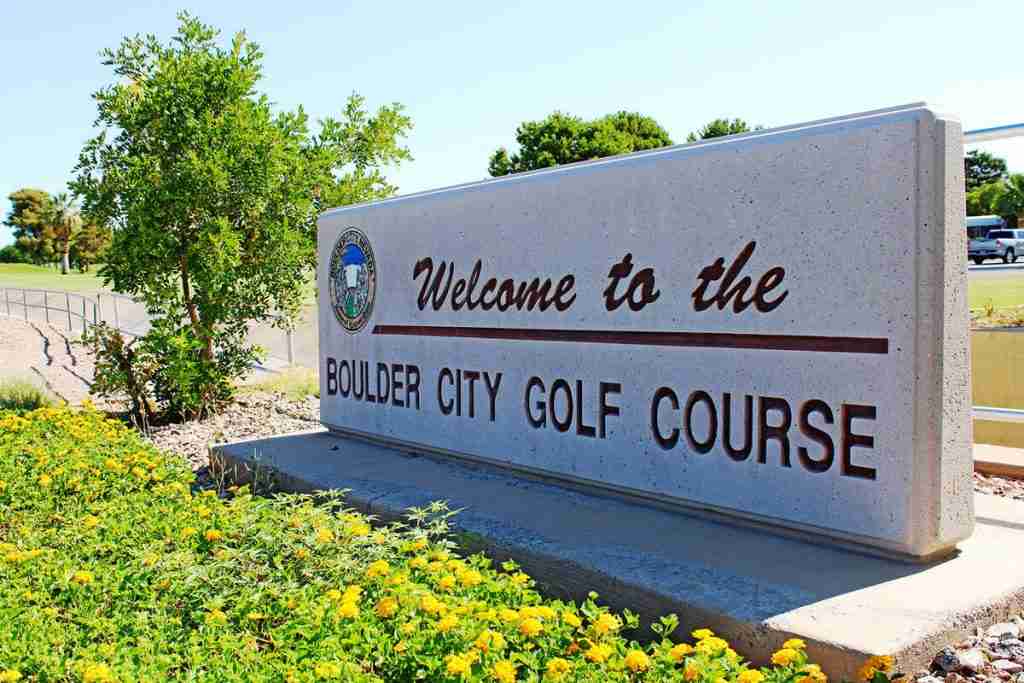
State-mandated turf removal from Boulder City’s municipal golf course has become a controversial local issue.
When Boulder City Municipal Golf Course opened in 1973, it was a sort of golden age for golf as a suburban pastime.
It was a time when everyone had their own set of golf clubs, Jack Nicklaus, Lee Trevino and Gary Player were on TV every weekend, and huge grassy golf courses were opening up all over the desert Southwest. Lake Mead was full, or nearly so. Droughts were common in other parts of the world, and discussions of climate change focused on what was being described as a coming ice age, and Clark County had a population of about 331,000.
Just over 50 years later, the lake level is about 200 feet below full level, more than 2.3 million people live in the area, and plans are being made for a possible future where there won’t even be enough water flowing into the Colorado River to generate electricity.
And in that context, a giant battle over water used to irrigate golf courses has erupted in Boulder City, as water officials are demanding that about a third of the turf on what some have described as the “jewel of Boulder City” be removed in the name of water conservation.
At a recent public meeting on the turf plans, residents floated ideas about using wastewater to irrigate the course and asked the city to wait to act until the current, old and leaky irrigation system is replaced.
But here’s the problem. The water used to irrigate the course and the need to remove the turf are two separate issues. In fact, according to city officials and the Southern Nevada Water Authority, even if the city’s course were under the current budget for golf course water use (which it is not, by a long shot), the turf would still have to be removed.
A tale of two problems
Although both issues revolve around the conservation of an increasingly precious resource – the water of the Colorado River – everything is separate, including legal authority.
Before the early 1990s, there were seven separate and often competing water districts serving Clark County, of which Boulder City was one. The state Legislature created SNWA as a sort of umbrella organization to manage water issues for the entire region and gave the group the legal authority to do so. So instead of managing its own water use independently, Boulder City gets a representative on the SNWA board to advocate for its needs. Currently, the representative is City Councilmember Steve Walton.
As the water situation in the Southwest became increasingly dire, SNWA took conservation measures, many of which affected golf courses.
The most significant measure was a complete moratorium on new course construction in Southern Nevada. But existing courses were also asked to moderate their water use. In 2021, golf courses’ water budgets called for them to use no more than 6.23 acre-feet of water per year per irrigated acre. An acre-feet of water is the amount of water needed to cover one acre of land with one foot of water, or about 326,000 gallons.
But since this year, that budget has been cut significantly. The current budget is four acre/feet per year per irrigated acre.
According to the presentation made at this public meeting by SNWA Conservation Services Administrator Patrick Watson, in 2021, based on the most recent data available, the Municipality of Boulder City was using approximately 8.8 acre/feet per year per irrigated acre.
For comparison, according to the graph used in Watson’s presentation, North Las Vegas has three golf courses that used about 12 acre/feet per irrigated acre in 2021. Boulder City has three courses (two public, one private) that in 2021 used nearly 21 acre/feet.
Being so far out of budget for water comes at a cost. A steep cost. The city’s water uses more than double the water budgeted for. And for every gallon of water over budget, Boulder City pays double the maximum water rate. Above 120 percent, the maximum rate is five times higher, and above 140 percent, the penalty is nine times higher.
According to the city’s estimates, the upcoming reconstruction of the municipal irrigation system will save a significant amount of water, but not enough to cover the current water budget.
AB356
But even if repairing the old irrigation system was enough to bring the use within budget, the turf would still have to be removed.
In 2021, the state Legislature overwhelmingly passed House Bill 356, which addresses water used to irrigate “nonfunctional turf.” Single-family residences are exempt, but everyone else has until January 1, 2027, to dispose of any turf that doesn’t have a “functional use.”
According to SNWA, this includes street grass, frontage grass, roundabout grass, courtyard grass and grass between buildings. When it comes to golf courses, this means any grass in “non-play” areas.
Which brings us to current plans to remove about a third of the existing turf on the municipal course.
Boulder Creek, which opened in 2003, was already consuming less water due to its design. At that time, courses were designed with greater consideration for the existing landscape.
Renowned golf course architect Mark Rathert had a specific plan for the Boulder Creek project when he designed it.
“I am very proud of Boulder Creek Golf Course and our vision was to create a golf experience for municipal golfers that would emulate the characteristics of exclusive Las Vegas clubs,” said Rathert. “The course design took advantage of the natural sandy terrain and was accented by lakes, streams and waterfalls to provide an oasis-like feel on many holes. The design promotes long-term sustainability for maintenance requirements, while providing quality conditions at an affordable price per round.”
In contrast, a SNWA spokesperson described the Boulder City municipal field as an “older, all-turf design.”
Wastewater problems
One of the issues that came up repeatedly at the last public meeting was the idea of using some of the more than 300 million gallons of wastewater that Boulder City sends each year to evaporation ponds in the desert to irrigate golf courses and parks. And that might just happen.
Boulder City is the only municipality in the Las Vegas area that doesn’t recycle wastewater. In 2020, SNWA proposed building — and funding — a six-mile pipeline from Boulder City to Henderson that would carry wastewater from British Columbia to a place where it could be injected into the system that sees more than 90 percent of the region’s inland wastewater cleaned, treated, and returned to Lake Mead, drawing water from the lake again and again to meet local needs.
But city officials rejected the proposed project. Then-Mayor Kiernan McManus told the Review four years ago: “It is clear to me that the proposed project is not about reclaiming water, but is actually about supporting the rapid development of the Eldorado Valley below Railroad Pass. What concerns me even more is SNWA’s stated intention to impose changes to the conservative growth policies that have benefited Boulder City for decades.”
Last year, the city agreed to a feasibility study by SNWA for wastewater treatment. The previously proposed pipeline still appears off the table, but proposals for irrigation use and the construction of an injection well to return treated wastewater from B.C. to Lake Mead are under consideration.
According to SNWA, they hope to have the results of this study by the end of this year and share them with the city council in the first months of 2025.
Next steps
Citizens, who have been vocal in their opposition to any changes to the municipal course, were encouraged to write down their thoughts on the current plan to reduce the grass area. These written thoughts will be compiled by council staff, who will discuss the grass reduction at a future meeting.
Mayor Joe Hardy and Council members Walton and Sherri Jorgensen were all present at the meeting.
In response to a request for comment, Walton said, “It was very helpful for me to be at the town meeting and hear first-hand the concerns of our residents, including those who live adjacent to the golf course. Complying with the requirements of AB356 can be complicated, especially for a community as small as Boulder City.”
“The information provided by SNWA last Monday night was helpful in providing some clarity to some extent. The City Council now has the opportunity to work with residents and staff to find the best solution that balances compliance with our adopted water conservation ordinance, as well as the integrity of the aesthetics, playability and inherent qualities of the municipal golf course. Boulder City has been a good steward of water conservation efforts, but more needs to be done due to recent legislation. Additionally, I look forward to the Council receiving the results of the wastewater feasibility study later this year so that we can determine which conservation effort would best serve Boulder City: direct reuse of water for irrigation or returning treated wastewater to Lake Mead.”
